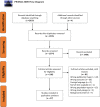IgE autoantibodies and autoreactive T cells and their role in children and adults with atopic dermatitis
- PMID: 32774842
- PMCID: PMC7398196
- DOI: 10.1186/s13601-020-00338-7
IgE autoantibodies and autoreactive T cells and their role in children and adults with atopic dermatitis
Abstract
The pathophysiology of atopic dermatitis (AD) is highly complex and understanding of disease endotypes may improve disease management. Immunoglobulins E (IgE) against human skin epitopes (IgE autoantibodies) are thought to play a role in disease progression and prolongation. These antibodies have been described in patients with severe and chronic AD, suggesting a progression from allergic inflammation to severe autoimmune processes against the skin. This review provides a summary of the current knowledge and gaps on IgE autoreactivity and self-reactive T cells in children and adults with AD based on a systematic search. Currently, the clinical relevance and the pathomechanism of IgE autoantibodies in AD needs to be further investigated. Additionally, it is unknown whether the presence of IgE autoantibodies in patients with AD is an epiphenomenon or a disease endotype. However, increased knowledge on the clinical relevance and the pathophysiologic role of IgE autoantibodies and self-reactive T cells in AD can have consequences for diagnosis and treatment. Responses to the current available treatments can be used for better understanding of the pathways and may shed new lights on the treatment options for patients with AD and autoreactivity against skin epitopes. To conclude, IgE autoantibodies and self-reactive T cells can contribute to the pathophysiology of AD based on the body of evidence in literature. However, many questions remain open. Future studies on autoreactivity in AD should especially focus on the clinical relevance, the contribution to the disease progression and chronicity on cellular level, the onset and therapeutic strategies.
Keywords: Atopic dermatitis; Autoallergens; Autoreactive T cells; Autoreactivity; IgE autoantibodies.
© The Author(s) 2020.
Conflict of interest statement
Competing interestsThe authors declare that they have no competing interests.
Figures



Similar articles
-
Autoreactive T cells and their role in atopic dermatitis.J Autoimmun. 2021 Jun;120:102634. doi: 10.1016/j.jaut.2021.102634. Epub 2021 Apr 20. J Autoimmun. 2021. PMID: 33892348 Review.
-
Immunoglobulin E autoantibodies in atopic dermatitis associate with Type-2 comorbidities and the atopic march.Allergy. 2023 Dec;78(12):3178-3192. doi: 10.1111/all.15822. Epub 2023 Jul 24. Allergy. 2023. PMID: 37489049
-
Does "autoreactivity" play a role in atopic dermatitis?J Allergy Clin Immunol. 2012 May;129(5):1209-1215.e2. doi: 10.1016/j.jaci.2012.02.002. Epub 2012 Mar 10. J Allergy Clin Immunol. 2012. PMID: 22409986
-
IgE Autoreactivity in Atopic Dermatitis: Paving the Road for Autoimmune Diseases?Antibodies (Basel). 2020 Sep 8;9(3):47. doi: 10.3390/antib9030047. Antibodies (Basel). 2020. PMID: 32911788 Free PMC article. Review.
-
Characterization of IgE-reactive autoantigens in atopic dermatitis. 2. A pilot study on IgE versus IgG subclass response and seasonal variation of IgE autoreactivity.Int Arch Allergy Immunol. 1999 Oct;120(2):117-25. doi: 10.1159/000024229. Int Arch Allergy Immunol. 1999. PMID: 10545765
Cited by
-
Atopic dermatitis: a need to define the disease activity.Front Med (Lausanne). 2023 Nov 3;10:1293185. doi: 10.3389/fmed.2023.1293185. eCollection 2023. Front Med (Lausanne). 2023. PMID: 38020127 Free PMC article. No abstract available.
-
Emerging Biologic Therapies for the Treatment of Atopic Dermatitis.Drugs. 2024 Nov;84(11):1379-1394. doi: 10.1007/s40265-024-02095-4. Epub 2024 Oct 4. Drugs. 2024. PMID: 39365406 Free PMC article. Review.
-
Association between organophosphate pesticide exposure and atopic dermatitis: a cross-sectional study based on NHANES 1999-2007.Front Public Health. 2025 Mar 6;13:1555731. doi: 10.3389/fpubh.2025.1555731. eCollection 2025. Front Public Health. 2025. PMID: 40115349 Free PMC article.
-
Portulaca oleracea L. extracts alleviate 2,4-dinitrochlorobenzene-induced atopic dermatitis in mice.Front Nutr. 2022 Aug 16;9:986943. doi: 10.3389/fnut.2022.986943. eCollection 2022. Front Nutr. 2022. PMID: 36051905 Free PMC article.
-
Exposure to isocyanates predicts atopic dermatitis prevalence and disrupts therapeutic pathways in commensal bacteria.Sci Adv. 2023 Jan 6;9(1):eade8898. doi: 10.1126/sciadv.ade8898. Epub 2023 Jan 6. Sci Adv. 2023. PMID: 36608129 Free PMC article.
References
-
- Wollenberg A, Barbarot S, Bieber T, Christen-Zaech S, Deleuran M, Fink-Wagner A, et al. Consensus-based European guidelines for treatment of atopic eczema (atopic dermatitis) in adults and children: part I. J Eur Acad Dermatol Venereol. 2018;32(5):657–682. - PubMed
-
- Illi S, von Mutius E, Lau S, Nickel R, Grüber C, Niggemann B, et al. The natural course of atopic dermatitis from birth to age 7 years and the association with asthma. J Allergy Clin Immunol. 2004;113(5):925–931. - PubMed
-
- Spergel JM. Epidemiology of atopic dermatitis and atopic march in children. Immunol Allergy Clin N Am. 2010;30(3):269–280. - PubMed
-
- Mortz CG, Andersen KE, Bindslev-Jensen C. Recall bias in childhood atopic diseases among adults in the Odense Adolescence Cohort Study. Acta Derm Venereol. 2015;95(8):968–972. - PubMed
Publication types
LinkOut - more resources
Full Text Sources
Other Literature Sources

